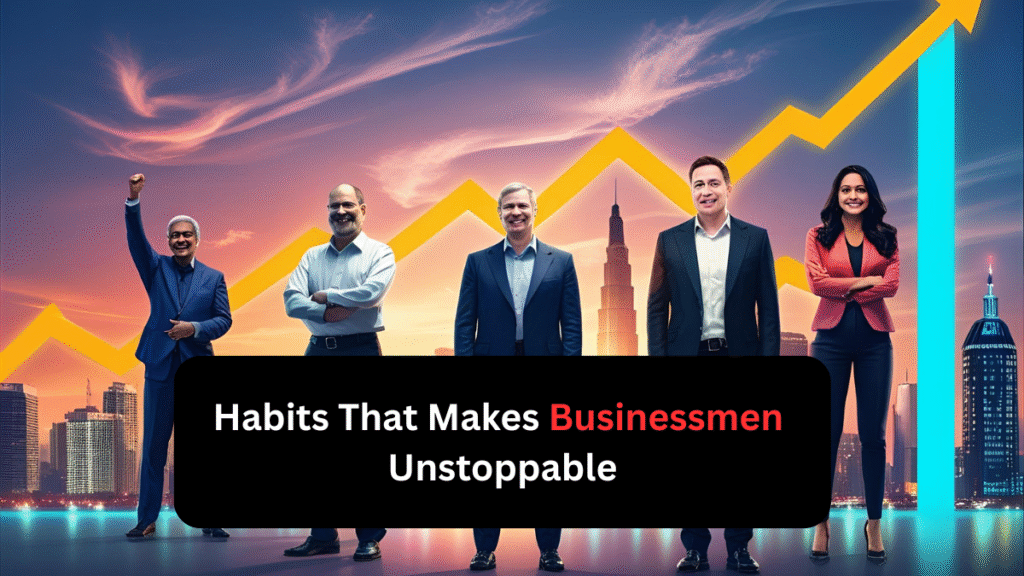5 Inspiring Real Motivational Stories of Business Leaders & the Habits That Made Them Unstoppable

Real Motivational Stories | Success rarely happens overnight. It’s a long, often arduous journey paved with countless obstacles, moments of self-doubt, and the relentless pursuit of a dream. Behind every billionaire, every industry leader, and every household name, there lies a deeply personal and often challenging narrative. These aren’t just tales of grand achievements; they are real motivational stories of individuals who transformed adversity into opportunity and built legacies through sheer will, innovative thinking, and an unwavering commitment to powerful habits.
In a world saturated with quick-fix solutions, these five incredible entrepreneurs offer a profound reminder that true success is forged in the fires of persistence and shaped by consistent, disciplined action. Let’s delve into their lives and uncover the core habits that made them unstoppable.
1. Dhirubhai Ambani – From Petrol Pump Attendant to India’s Business Tycoon | Real Motivational Stories
The story of Dhirubhai Ambani is one of the most compelling real motivational stories from India, a testament to what an audacious vision and an iron will can achieve. Born in 1932 in the humble village of Chorwad, Gujarat, to a school teacher, Dhirubhai’s formal education ended early. His journey began not in a boardroom, but at a petrol pump in Aden, Yemen, where he worked for A. Besse & Co. in the late 1940s. Here, he earned a modest salary but gained invaluable insights into international trade, currency fluctuations, and market dynamics. He was a keen observer, absorbing every detail of how businesses operated on a global scale.
With a mere ₹15,000 (equivalent to a few hundred dollars at the time) and an audacious dream, Dhirubhai returned to India in 1958. He didn’t have a business degree or family connections; what he possessed was an unparalleled ambition and a sharp business acumen. He started with a small trading operation, importing polyester yarn and exporting spices. His initial office was a modest 350 sq ft room, shared with a table and three chairs. He would sleep in the office, working tirelessly, often well past midnight.
His pivotal moment came when he ventured into textiles, establishing Reliance Commercial Corporation in 1966. He meticulously studied the textile market, understanding the demand-supply gaps. While others feared volatility, Dhirubhai saw opportunity. He famously built the Vimal textile brand, revolutionizing how textiles were manufactured and marketed in India. He introduced modern machinery, focused on quality, and created a brand that resonated with the aspirations of a rising middle class.
Key Habit: Thinking Big and Taking Calculated Risks. Dhirubhai didn’t just think big; he thought exponentially. When others were content with small-scale trading, he envisioned integrated manufacturing facilities. When he needed capital, he democratized wealth creation by encouraging ordinary Indians to invest in his company, long before public offerings were common. He understood the power of scale and was never afraid to take massive, calculated risks. For instance, he took on the powerful established players in the textile industry by setting up a synthetic fabric plant, despite immense opposition. He saw beyond immediate challenges, always planning for the next decade, not just the next quarter. His ability to anticipate market trends and make bold, often contrarian, moves was the cornerstone of his empire-building strategy, making his journey one of the most inspirational real motivational stories for aspiring entrepreneurs.
2. Steve Jobs – The College Dropout Who Revolutionized Technology
Among the most iconic real motivational stories in the tech world is that of Steve Jobs, a figure synonymous with innovation and design. Born in San Francisco and adopted shortly after, Jobs’ early life was unconventional. He dropped out of Reed College after just one semester, finding formal education restrictive. However, his “dropping out” was far from “giving up.” Instead, he audit classes that genuinely interested him, like calligraphy, a seemingly minor detail that would later profoundly influence the beautiful typography of the Macintosh computer.
His true calling emerged in 1976 when, with his friend Steve Wozniak, he co-founded Apple Computer in his parents’ garage. Their initial product, the Apple I, was a humble circuit board. But it was the Apple II that became one of the first truly successful mass-produced personal computers, catapulting Apple into the limelight. Jobs wasn’t just building computers; he was selling a vision of technology empowering individuals.
Despite early triumphs, Jobs’ journey was far from smooth. His relentless pursuit of perfection and his intense, sometimes abrasive, management style led to internal conflicts. In a stunning turn of events, he was ousted from Apple in 1985, the very company he co-founded. This period, though painful, proved to be a crucible for his future success. He went on to found NeXT, a computer platform development company, and acquired Pixar Animation Studios, transforming it into a animation powerhouse.
His return to Apple in 1997, when the company was on the brink of bankruptcy, is legendary. He meticulously pruned product lines, galvanized the team, and spearheaded the creation of revolutionary products like the iMac, iPod, iTunes, iPhone, and iPad. He didn’t just save Apple; he redefined industries.
Key Habit: Relentless Focus on Innovation and Design Perfection. Jobs was obsessed with the user experience. He famously said, “Design is not just what it looks like and feels like. Design is how it works.” This wasn’t merely a slogan; it was a deeply ingrained habit. He would spend countless hours agonizing over the smallest details, from the curvature of a device to the intuitiveness of its software. He pushed his engineers and designers to unimaginable limits, often rejecting prototypes that didn’t meet his exacting standards. This relentless pursuit of perfection wasn’t always easy for those around him, but it resulted in products that were not just functional, but beautiful, intuitive, and desirable. His unwavering belief that technology should be elegant and user-friendly, combined with his visionary thinking, made Apple a global phenomenon and solidifies his place in real motivational stories.
3. Oprah Winfrey – From Poverty to Media Mogul
Oprah Winfrey’s life is one of the most profoundly moving and inspiring real motivational stories of overcoming adversity imaginable. Born into extreme poverty in rural Mississippi in 1954, her early life was marked by immense hardship, including abuse and neglect. Moving between different relatives and struggling with a lack of stability, many would have crumbled under the weight of such a beginning. Yet, Oprah possessed an innate resilience and an extraordinary ability to connect with people.
Despite her challenging circumstances, she excelled academically and displayed a remarkable talent for public speaking from a young age. Her broadcasting career began in high school, working at a local radio station. She then transitioned to television, becoming the youngest person and the first African American woman to anchor the news at Nashville’s WTVF-TV. However, the rigid format of news broadcasting didn’t allow her natural empathy and conversational style to shine.
Her career took a pivotal turn when she moved to Chicago in 1984 to host a local talk show, “AM Chicago.” Within months, her authentic, empathetic, and often raw approach to interviewing captivated audiences, turning the struggling show into a ratings phenomenon. Renamed “The Oprah Winfrey Show” in 1986, it quickly became nationally syndicated and redefined the talk show genre. Oprah wasn’t just interviewing guests; she was having profound conversations, tackling sensitive topics, and creating a safe space for millions to share their stories.
Through the show, she built a media empire. She founded Harpo Productions (Oprah spelled backward) in 1986, giving her full ownership of her show and all its content—an unprecedented move for a female television personality at the time. This ownership allowed her to diversify into magazines (O, The Oprah Magazine), film production, and eventually, her own television network, OWN (Oprah Winfrey Network). She became the first African American woman billionaire, a testament to her vision and business acumen.
Key Habit: Empathy and Connecting Deeply with People. Oprah’s superpower was her unparalleled ability to connect with people on a deeply emotional level. She didn’t just listen; she felt what her guests and audience were going through. This wasn’t a facade; it was an authentic part of her personality, honed by her own life experiences. She transformed television from a passive viewing experience into an active, communal conversation. This empathy allowed her to build immense trust and loyalty with her audience, leading to groundbreaking conversations and a dedicated following. She understood that at the heart of every person is a story, and by genuinely connecting with those stories, she could inspire, heal, and empower. Her commitment to understanding the human experience makes her one of the most compelling figures in real motivational stories.
4. Elon Musk – The Visionary Who Pushes Limits
Elon Musk’s journey is one of the most audacious and futuristic real motivational stories of our time. Born in Pretoria, South Africa, in 1971, Musk displayed an early fascination with technology and entrepreneurship. He taught himself computer programming at age 10 and sold his first game, “Blastar,” at 12. His academic pursuits led him to Queen’s University in Canada and then to the University of Pennsylvania, where he earned degrees in physics and economics.
In 1995, he dropped out of a Stanford Ph.D. program to join the internet boom, co-founding Zip2, an online city guide software company. He sold Zip2 for over $300 million in 1999. His next venture, X.com, an online financial services company, merged to become PayPal, which was acquired by eBay for $1.5 billion in 2002. Rather than resting on his laurels, Musk immediately reinvested his substantial earnings into three wildly ambitious, seemingly impossible ventures: SpaceX, Tesla, and SolarCity.
Each of these companies faced immense skepticism, technical challenges, and near-bankruptcy multiple times. SpaceX, aiming to revolutionize space travel, endured multiple failed rocket launches that consumed vast amounts of capital and drew widespread criticism. Tesla, his electric vehicle company, struggled with production hell and financial solvency, often ridiculed by traditional automakers. Yet, Musk, with his unyielding belief in his vision, pushed forward. He slept on the factory floor, personally oversaw production, and faced down critics with an almost defiant optimism.
Today, SpaceX is a leading private space company, regularly launching rockets and sending astronauts to the International Space Station. Tesla has revolutionized the automotive industry, becoming the world’s most valuable carmaker. His other ventures, Neuralink (brain-computer interfaces) and The Boring Company (underground tunnels), continue to push the boundaries of what’s possible.
Key Habit: Extreme Perseverance and a High Tolerance for Failure. Musk’s defining habit is his almost superhuman ability to persevere in the face of overwhelming odds and repeated failures. For him, failure isn’t a setback; it’s a data point, an opportunity to learn and iterate. He embodies the mantra that “If things are not failing, you are not innovating enough.” He has faced public ridicule, financial ruin, and intense pressure, yet his commitment to his long-term vision—making humanity a multi-planetary species, accelerating the world’s transition to sustainable energy, and merging human and artificial intelligence—remains unshaken. His tolerance for risk and his sheer willpower to push through seemingly insurmountable obstacles make his one of the most compelling and inspiring real motivational stories.
5. Sara Blakely – Turning $5,000 into a Billion-Dollar Brand
Sara Blakely’s journey from selling fax machines door-to-door to becoming the youngest self-made female billionaire is a remarkable one among real motivational stories. Born in 1971 in Clearwater, Florida, Blakely’s early career was far from glamorous. She spent seven years selling fax machines, enduring rejections daily. This experience, however, honed her sales skills and developed her resilience.
The idea for Spanx came to her in 1998 when she was getting ready for a party. Frustrated with visible panty lines and the unflattering fit of her undergarments under white pants, she cut the feet off her pantyhose, instantly creating a smoother silhouette. This simple act sparked a revolutionary idea: shapewear that was comfortable, effective, and invisible.
With only $5,000 in savings and no prior business experience, fashion industry connections, or investors, Blakely embarked on her entrepreneurial journey. She wrote her own patent application, meticulously researching and understanding the process. She spent two years developing her product, facing numerous rejections from hosiery mills who dismissed her idea. She drove across North Carolina, visiting various mills until she found one willing to take a chance on her.
Her big break came when she cold-called a Neiman Marcus buyer and, in a bold move, demonstrated the product in the buyer’s office. The buyer was impressed, and Spanx was soon on the shelves. Oprah Winfrey’s endorsement in 2000, calling Spanx one of her “Favorite Things,” catapulted the brand into national prominence. Blakely’s dedication to quality, her understanding of what women truly wanted, and her ingenious marketing strategies (often featuring herself) led to explosive growth. She famously retained 100% ownership of her company, a rarity that significantly contributed to her wealth.
Key Habit: Resourcefulness and Believing in Her Own Idea. Sara Blakely’s success is a masterclass in resourcefulness. With limited funds and no network, she found creative ways to develop her product, protect her intellectual property, and secure distribution. She didn’t wait for permission or external validation; she made things happen. Her unwavering belief in her own idea, even when faced with universal skepticism from manufacturers and industry insiders, was her most powerful asset. She trusted her gut, listened to her instincts, and refused to let setbacks define her. Her ability to innovate with limited resources and her profound self-belief make her story one of the most empowering real motivational stories for aspiring entrepreneurs, especially women.
✅ Habits Chart: What All These Successful People Have in Common
While their paths and industries diverged, these five titans of business shared a common set of powerful habits that underpinned their monumental success. These aren’t just traits; they are actionable principles that anyone can cultivate.
| Habit | How It Helped Them |
| 1. Visionary Thinking | They saw opportunities where others saw limitations, envisioning entirely new industries or revolutionary solutions. |
| 2. Calculated Risk-Taking | They took bold, often contrarian steps despite uncertainty, understanding that true growth requires stepping outside comfort zones. |
| 3. Resilience Under Pressure | They continued relentlessly despite failures, criticism, financial setbacks, and immense personal challenges. |
| 4. Continuous Learning & Innovation | They were perpetual students, always seeking to improve, adapt, and push the boundaries of what was possible. |
| 5. Strong Work Ethic & Discipline | Their empires were built on consistent, diligent daily effort, often involving long hours and unwavering focus. |
| 6. Customer/User Focus | Whether it was Ambani’s understanding of market demand or Jobs’ and Oprah’s focus on user experience/connection, they prioritized their audience. |
| 7. Self-Belief & Conviction | They possessed an unwavering conviction in their ideas and their ability to execute, even when no one else believed. |




